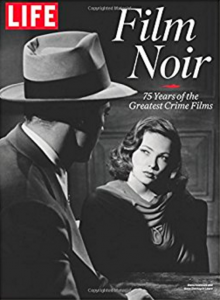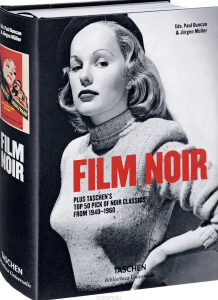What Is the Film Noir File?
The Film Noir File challenges standard interpretations of film noir, which have been presented as facts — both in the mass media and academic literature. These interpretations belong to what I call “the film noir hardboiled paradigm.”
For example, in autumn 2016, Life magazine published an issue solely devoted to “Film Noir: 75 Years of the Greatest Crime Films.” The opening chapter under “Classic Noir” is called, “A Genre Is Born: How German film and pulp fiction inspired a uniquely American art form.”

The first paragraph, by editor and author J.J. Baker, begins as follows:
“The film genre that the French would eventually dub noir (meaning “black”) was created when the visual tropes of German expressionism (think the stark, angular chiaroscuro and Teutonic angst reflected in such silent classics as Nosferatu and The Cabinet of Dr. Caligari) were combined with the influence of the pulp and hard-boiled crime fiction that had been popularized in large part by an American magazine called Black Mask. Influenced by the terse realism of Ernest Hemingway’s fiction, the stories limned a seamy world of fedoras, cheap booze, cheaper bars, guns and gumshoes, double-crossing dames, cynicism, doomed boxers, doomed dreamers, doomed gamblers, and doom itself.” (New York: Time, Inc. Books, 8)
A decade before, an approximate summary of the ideas in the film noir hardboiled paradigm, by movie critic Sura Wood, in “Film Noir Steps Out of the Shadows,” was published on the front page of the San Francisco Arts Monthly (January 2006).
The Film Noir File challenges Wood’s description of film noir on point after point. (Italics in Wood’s quotes are mine).
“Though the French coined the term, film noir is a distinctly American phenomenon.” This represents the hardboiled paradigm, which I challenge because it is incorrect. See the pages under Spy Noirs & the Origins of Film Noir in the UK & US as well as Internationalism of Film Noir, 1923-1963.
“Known for minimalism and snappy dialogue, these low-budget, black and white, highly stylized movies, which reached their apex in the late ’40s and early ’50s, were stories usually told from a criminal’s point of view, about desperate people driven to the brink.” This represents the hardboiled paradigm, which I challenge because it is incorrect. See the pages under Against the Hardboiled Paradigm as well as Spy Noirs & the Origins of Film Noir in the UK & US.
“The noir universe was populated by a carnival of colorful, shady, often violent characters, who dwelled in an underworld or on the fringes of a fever dream; trouble lurked around each corner.” This represents the hardboiled paradigm, which I challenge because it is incorrect. See the pages under Against the Hardboiled Paradigm, as well as Spy Noirs & the Origins of Film Noir in the UK & US, The Film Noir PI: Made in the ’70s, and The Not Hardboiled PI in Film Noir.
“Noir has its roots in the pulp fiction/crime dramas of writers Dashiell Hammett, James M. Cain, Raymond Chandler, Cornell Woolrich, Patricia Highsmith and other authors who cut their teeth on the fiction of the 1930s.” This represents the hardboiled paradigm, which I challenge because it is incorrect. See the pages under Against the Hardboiled Paradigm. And in the page Spy Noirs & the Origins of Film Noir in the UK & US, in the section Spy Noirs Contradict Film Noir’s “Origins Myths,” see the first subsection Film Noir Is Not Derived from Hardboiled Crime Fiction.
“Its look was influenced by Orson Welles’ Citizen Kane, as well as German Expressionism, imported to the U.S. by émigré directors such as Billy Wilder, Edgar Ulmer and Robert Siodmak, who experienced the rise of Nazism and brought with them a pessimistic, existential vision.” This represents the hardboiled paradigm, which I challenge because it is incorrect. See the pages under What Explains the Visual Style of Film Noir? And in the page Spy Noirs & the Origins of Film Noir in the UK & US, see the section Spy Noirs Refute Claims that the Noir Style Is Derived from European Émigrés and the following section What Explains the Noir Style in the Origins of Film Noir?
“No film noir festival would be complete with that staple of noir myth, the femme fatale, a woman who is as relentless as she is unsentimental. The iconic femme fatale is devastatingly beautiful, seductive and more driven by a lust for power than by passion.” This represents the hardboiled paradigm, which has ignored other equally important female characters, especially the woman in distress, the good spy and the underground resistance fighter. See the pages Significance of the Woman in Distress and Woman in Distress vs. Femme Fatale. Also, see pages under Against the Hardboiled Paradigm and Spy Noirs and the First Femme Fatales.
For my challenge to Sura Wood’s claim that the femme fatale “is as relentless as she is unsentimental” – or in the words of Foster Hirsch, another exponent of the hardboiled paradigm, that the femme fatale “cannot be humanized” – see my discussion and historical periodization of the “soft” femme fatale in the page International Lady. The page also provides a comparison of the close similarities with this spy noir and the crime noir The Maltese Falcon. Additionally, the page explains the “hard” femme fatale. In the page Quiet Please, Murder, I review a hard femme fatale in a spy noir, which was released in 1942, two years before the first crime noir with a hard femme fatale.
The stereotypical concoction of plot features, iconic characters, plus émigré directors in the hardboiled film noir paradigm are cited for “Assemble the Elements” on the website of the British Film Institute (BFI) on July 22, 2015, under “Infographic: What Makes a Film Noir?” The purpose of The Film Noir File is to challenge the BFI’s simplistic, even misleading, representation of film noir, as well as to provide evidence that film noir is far more complicated, expansive and interesting than the BFI’s constricted assemblage of “elements.”
2018: Same as It Ever Was
 A couple of years after the publication of the special issue of Life magazine, film noir historians Alain Silver and James Ursini provided a thorough overview of the tenets of the film noir hardboiled paradigm in the Introduction, “What is ‘Noir'”?, in Film Noir, editors Paul Duncan and Jürgen Müller (Taschen, 2018).
A couple of years after the publication of the special issue of Life magazine, film noir historians Alain Silver and James Ursini provided a thorough overview of the tenets of the film noir hardboiled paradigm in the Introduction, “What is ‘Noir'”?, in Film Noir, editors Paul Duncan and Jürgen Müller (Taschen, 2018).
The following are selected quotations:
“On the literary side, noir drew heavily from the works of the hard-boiled school of detective fiction, written by the likes of Dashiell Hammett, Raymond Chandler, James M. Cain, David Goodis, and Cornell Woolrich. Also influential were the writings of naturalist authors like Émile Zola and Ernest Hemingway, the latter being a particularly potent role model with his clipped and poetic prose style and pointed dialogue.” (12)
“On the artistic side, German Expressionism, with its chiaroscuro lighting, distorted camera angles, and symbolic designs, was probably the single most important influence on the look of film noir.” (12)
“It is natural that the values of Expressionism would seep into this already dark movement, but there is an even greater reason for its influence, because many of the most prominent directors of film noir in the classic period – Fritz Lang, Otto Preminger, Robert Siodmak, Billy Wilder, Edgar G. Ulmer, Max Ophuls, Jacques Tourneur and Jean Renoir – were émigrés from Europe. They had worked in Germany and France where Expressionism and poetic realism had been the dominant artistic movements for over a decade. What could be more natural than to apply the techniques of these movements, particularly when faced with the psychologically perverse and often fatalistic stories of the hard-boiled writers, as they created the noir cycle?” (11, 19)
“The most subversive element in most film noirs is the female character, who is often a femme fatale.” (20)
“Noir films draw their verbal power from the hard-boiled school of writing.” (27)
The Film Noir File also has other pages that I hope will interest you.
You can email me, Dan Hodges, here: dmhodges@pacbell.net